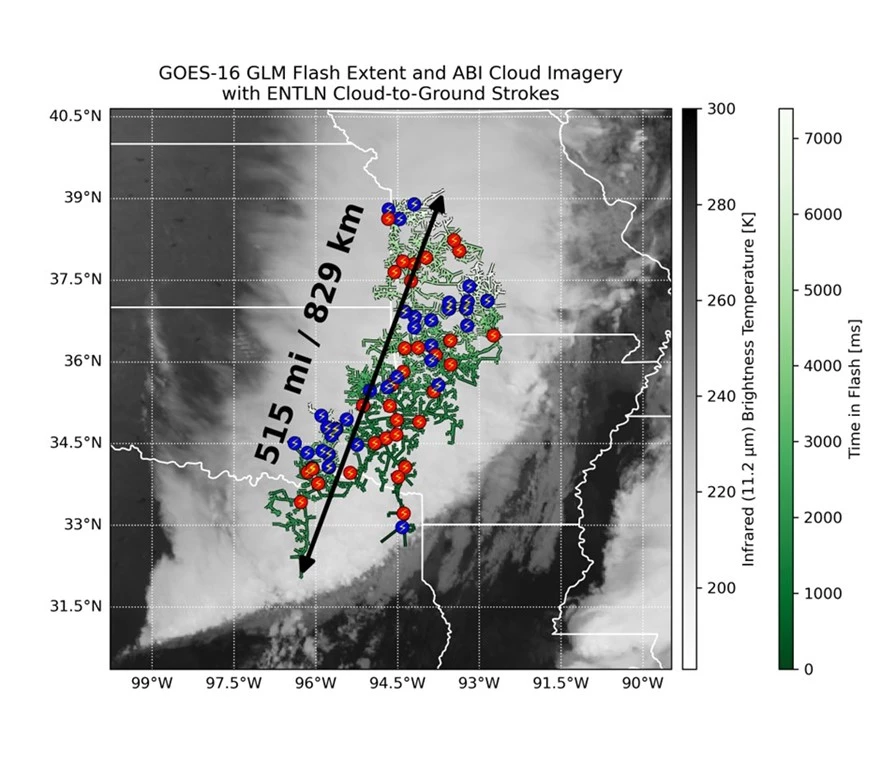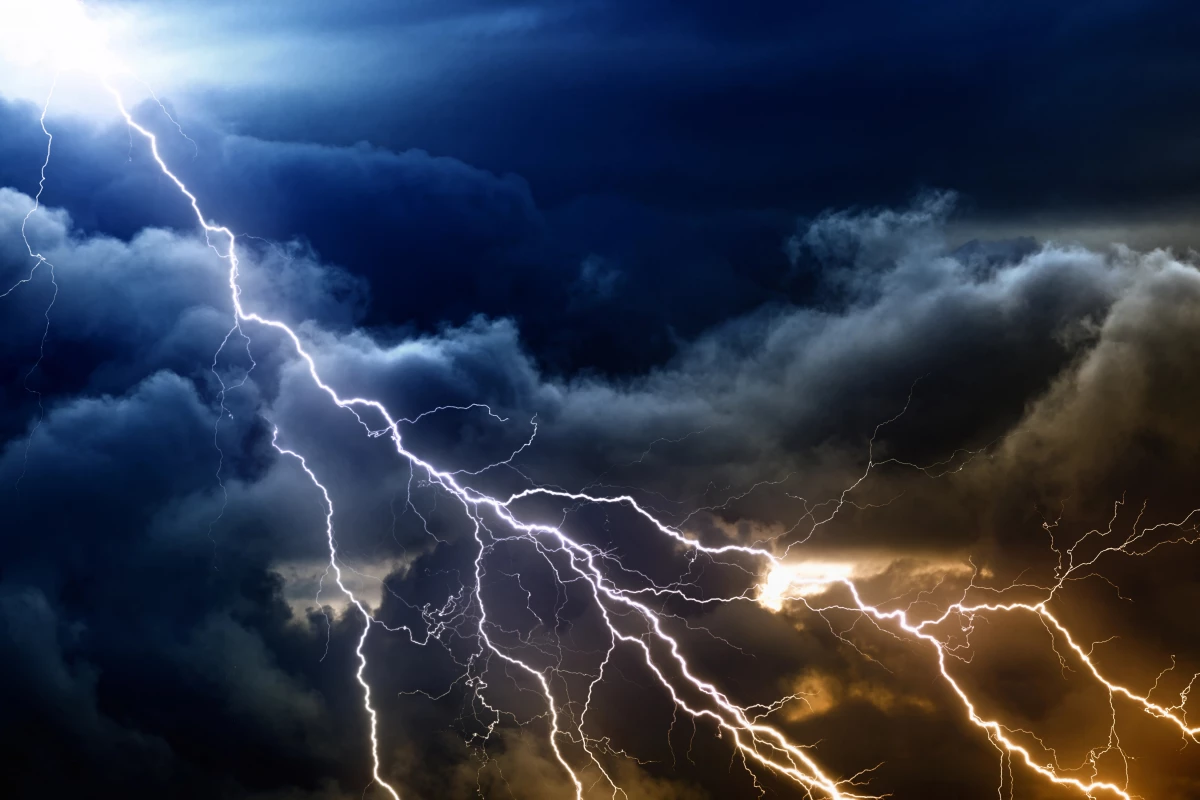A lightning bolt stretching 515 miles (829 km) from eastern Texas to near Kansas City has set a terrifying new record as the longest single lightning flash ever recorded. There are only two places on the entire planet where this kind of "megaflash" is likely to occur.
The World Meteorological Organization (WMO) has detailed this new world record for the longest lightning flash, which traveled 515 miles over North America's Great Plains, an infamous hotspot that produces epic storm clusters capable of generating such epic electrical charges.
As the name suggests, a megaflash is an incredibly long lightning strike, and are typically the work of Mesoscale Convective Systems (MCSs) – huge collections of thunderstorms that act as a single, ominous system. They can stretch across large states and rage for 12 hours or more. Fortunately for those of us on the ground, they're generally isolated to two ideal spots for them to form – over the Great Plains, which spans a vast area across central Canada and the US, and the La Plata basin of South America.
This 515-mile strike hit on October 22, 2017, traveling in seconds a distance that would take up to 90 minutes on an Airbus A320. It unseated the previous record, which was also a megaflash that originated over the Great Plains. Interestingly, that record was set in 2020 – by a 477.2-mile (768-km) fork that stretched across the southern US.
Thanks to advances in satellite technology, historical records can now be better analyzed. While it gives this hefty megaflash some well-deserved recognition, the developments in space-based weather tech is proving critical for predicting extreme events.
“Lightning is a source of wonder but also a major hazard that claims many lives around the world every year and is therefore one of the priorities for the international Early Warnings for All initiative," said WMO Secretary-General Celeste Saulo. "These new findings highlight important public safety concerns about electrified clouds which can produce flashes which travel extremely large distances and have a major impact on the aviation sector and can spark wildfires."
New space technologies include the US Geostationary Lightning Mappers (GLMs) on the R-series Geostationary Operational Environmental Satellites that recorded the 2017 record, plus Europe's Meteosat Third Generation (MTG) Lightning Imager and China's Y-4 Lightning Mapping Imager.
Previously, ground-based Lightning Mapping Array (LMA) networks recorded the distance and duration of strikes, however, there are upper limits to this system that can't accurately track outliers like megaflashes.
“Investigation of megaflashes is providing new insights into the mesoscale electrical charge variations in Mesoscale Convective System thunderstorms," said lightning specialist and committee member Walt Lyons. "Furthermore, it illustrates the threat of the newly recognized 'bolt from the gray,' analogous to the 'bolt from the blue' from isolated cells, but one that can travel many hundreds of kilometers from the main charge generating region."
The 2017 flash has been officially recognized in the WMO Archive of Weather and Climate Extremes, which records extremes for temperature, pressure, rainfall, hail, wind and lightning as well as tornadoes and tropical cyclones, across the globe. It wasn't originally identified in storm analysis at the time, but a re-examination uncovered it.

“This new record clearly demonstrates the incredible power of the natural environment," said Randall Cerveny, professor and rapporteur of Weather and Climate Extremes for WMO. "Additionally, WMO assessment of environmental extremes such as this lightning distance record testify to the significant scientific progress in observing, documenting and evaluating such events. It is likely that even greater extremes still exist, and that we will be able to observe them as additional high-quality lightning measurements accumulate over time."
In other record news, the longest duration of a single lightning strike was 17.102 seconds (with a 0.002 margin), during a storm over Uruguay and Argentina, on June 18, 2020. The most fatal strike was a single flash that killed 21 people in a Zimbabwean hut in 1975. And when lightning hit several oil tanks in Dronka, Egypt, in 1994, an ensuing flood of burning oil killed 469 people – the largest number of fatalities that resulted from an indirect strike.
“The extremes of what lightning is capable of is difficult to study because it pushes the boundaries of what we can practically observe," said lead author Michael J. Peterson, from the Severe Storms Research Center (SSRC) at the Georgia Institute of Technology. "Adding continuous measurements from geostationary orbit was a major advance. We are now at a point where most of the global megaflash hotspots are covered by a geostationary satellite, and data processing techniques have improved to properly represent flashes in the vast quantity of observational data at all scales.
“Over time as the data record continues to expand, we will be able to observe even the rarest types of extreme lightning on Earth and investigate the broad impacts of lightning on society,” he added.
While the chances of ending up on the receiving end of a megaflash are very, very slim, lightning strikes are one of the most dangerous natural phenomenons. Around 240,000 people are struck by lightning every year, and for an estimated 10% of these victims, it proves fatal. Survivors are often left with serious long-term health problems including neurological damage, burns and memory loss – as well as considerable trauma.
Most of us will have grown up hearing ways of how to minimize the risk of being struck – don't use a metal umbrella, wear rubber-soled shoes and don't stand under trees during a storm are three that come to mind. However, the best advice comes from lightning experts.
“The only lightning-safe locations are substantial buildings that have wiring and plumbing; not structures such as at a beach or bus stop," said Lyons. "The second reliably safe location is inside a fully enclosed metal-topped vehicle; not dune buggies or motorcycles.
"If lightning is within 10 km (6.2 miles) as found with reliable lightning data, go to the lightning safe building or vehicle," he added. "As these extreme cases show, lightning can arrive within seconds over a long distance, but they are embedded within larger thunderstorms, so be aware."
The research was published in the Bulletin of the American Meteorological Society.





